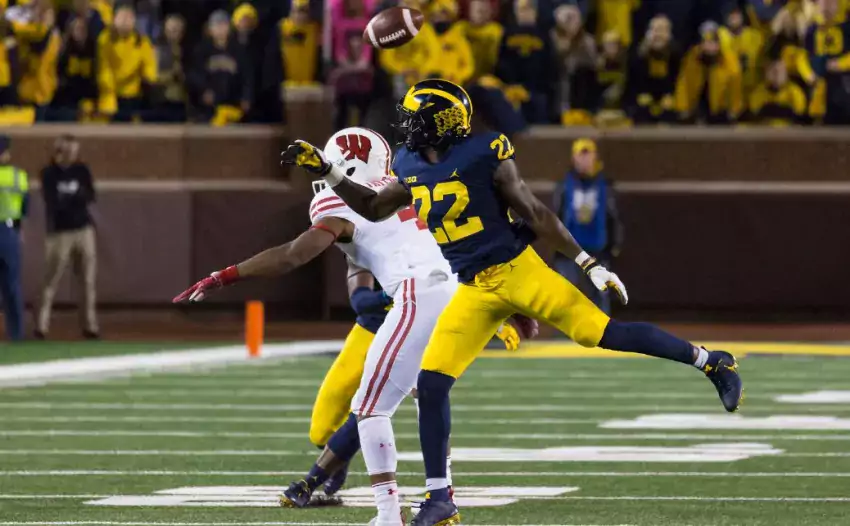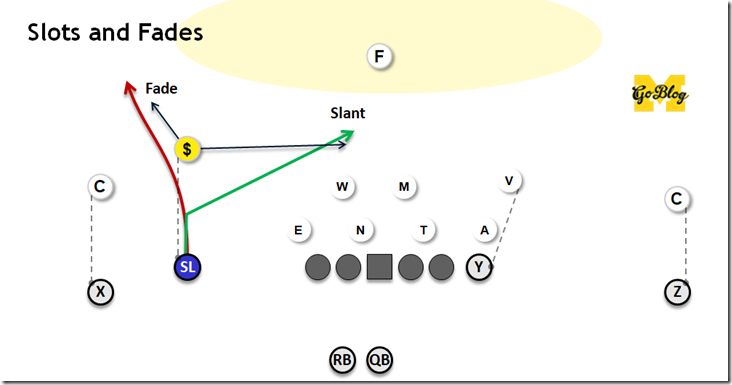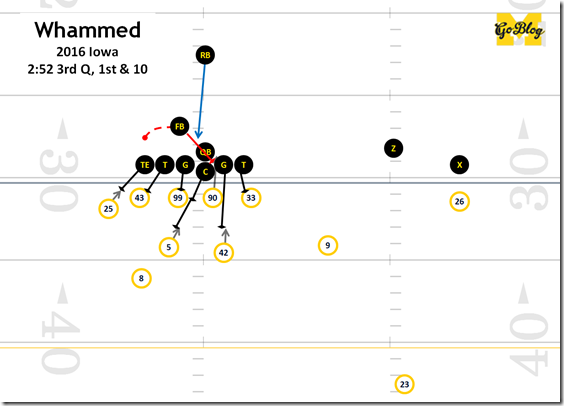it's-a-trap

Waaaaay back in the nonconference portion of the season Michigan was getting repeatedly gashed by slants. The problem hit a crescendo against SMU, and their excellent little slot bug James Proche.
SMU threw six slants for 44 yards on 4 completions; only on the last did a safety make a play on the ball, and there’s a big reason for that we’ll get into further down. As the season’s progressed, however, Michigan’s gotten much better not just at defending slants but convincing opposing offenses not to even bother with them by running trap coverages. Why were we bad at them before? Is that a hole in our base defense? What’s a trap coverage? Let’s discuss.
Defending Slants and Fades with Man Coverage
The reason Michigan was bad at slants was they were bad/unlucky last year at fades, and made a conscious decision to be align in a way that made fades harder and slants easier.
Michigan likes to run a lot of Cover 1: man to man defense with single high safety. They also like to blitz their linebackers and play them aggressively against the run. The coverage has help inside on deep plays but no help outside, and small help underneath. Offenses learned long ago that you can put a Cover 1 slot defender in a bind by threatening him short/inside (a slant) and deep/outside (a fade). Both routes start by running directly at this guy, trying to get him to flip his hips to defend whichever of the two you’re not running.
[After the JUMP: a wild Mon Calamari appears]
I used to be really good at slaps, that game where your opponent puts their hands over yours and you try to whack them before they can pull away. My best trick was I’d make my elbow twitch on one side then *WHAP* the other side. I’d get so many in a row with this that my siblings stopped wanting to play.
Tom Allen probably doesn’t want to play slaps with Harbaugh anymore.
This was a beautiful play. I thought so. Brian thought so. Jon Duerr thought so. James Light thought so. Harbaugh apparently liked it enough to call it three times in a five-play drive. We all guessed Michigan would have preferred not to put it on tape before the Penn State game but since it is let’s dive into it.
THE PLAY:
It’s early in the 4th quarter. Michigan is up just 13-10 over Indiana and gets the ball back on their 16 yard line after Indiana punts on 4th and 1. The first play is a split zone off the same look with which they’d successfully run a TE motion crack sweep, and it goes for 8 yards when Onwenu and Bredeson beat their respective DTs (Bredeson’s guy got up crying for a hold that was probably legit and is never called).
Then out comes this:
It’s a trap play, which itself isn’t very weird. On a trap the backside guard (Bredeson, #74) pulls and the frontside starts blocking down just like on a power play. But instead of having the DE kicked out by a tackle or tight end, they leave the edge guy for a moment and the puller then plows into him. The erstwhile kicker meanwhile is heading downfield hunting linebackers and safeties. The running back then charges through the hole, with a lead blocking fullback if that’s your style.
In this instance Hill didn’t even bother to block Tegray Scales, the WLB, because he’s stumbling over his buddy—Scales managed to right himself and make the tackle, else Higdon is following Hill into the secondary. That’s on Hill for going for a big gain and given the situation (2nd and 2) I’m fine with taking a shot when the worst result is still a first down. Anyway that’s not the interesting part.
The interesting parts are the path that Hill took, and the way they blocked the playside tackle. There are a lot of arrows in a tight space so let me show you who’s blocking whom with colors:
Let’s examine the two really cool wrinkles in detail.
[After THE JUMP]
I found this incredibly annoying this weekend:
Michigan has 8 1/2 in the box, and yet Iowa is able to get 8 yards on 1st down. Even more galling is they did it with a nifty trick that hadn’t been seen much of in the Big Ten until Harbaugh brought it back last year. It’s the wham. And it had no right to go this well.
Wham Defined
A wham is a first level block by the fullback or TE, freeing up an offensive lineman to release to the next level. It’s a type of Trap, which is a when you leave an interior defensive lineman unblocked before hitting him from another angle. But when you think of a “trap” it’s usually pulling an offensive lineman to blindside the DL you left unblocked to roar into the backfield.
A wham is less about catching the defense overreacting and more about winning a one-on-one matchup they didn’t expect, in this case between a fullback or H-back and an interior DL. The block is a kick-down, and happens within a second of the snap. If executed, you’ve erased the defense’s most important run defender with your fullback’s block, and your center (who’s often your best run blocker) gets a free release into the linebackers.
Wham block in red
Often a wham block starts with that fullback or tight end in motion. This keeps him out of view of the DT he’ll end up blocking until it’s almost too late, and can give him more of a head start, since the fullback is bound to be giving up some weight on the DT, and will have to make up for it with momentum.
BlueGraySky put together a great video compilation of Notre Dame’s wham blocks from a decade ago:
If you’re mad about watching Domers, know that Michigan’s ‘06 defense appears twice and does a pretty good job against it.
[After the JUMP: What they win, what they risk, and how it goes]



18